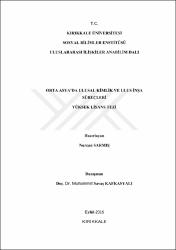| dc.contributor.advisor | Kafkasyalı, Muhammet Savaş | |
| dc.contributor.author | Sarmış, Nurcan | |
| dc.date.accessioned | 2021-01-16T18:55:08Z | |
| dc.date.available | 2021-01-16T18:55:08Z | |
| dc.date.issued | 2016 | |
| dc.identifier.uri | | |
| dc.identifier.uri | https://hdl.handle.net/20.500.12587/14474 | |
| dc.description | YÖK Tez ID: 448647 | en_US |
| dc.description.abstract | Bireyin kim olduğu ve nerede durduğu kimlik nedir sorusunun genel kabul gören en yalın yanıtıdır. Kimliğe dair yapılan tanımların gösterdiği genel kabule göre kimlik, fark üzerine inşa edilen bir süreçtir. Kimlik doğuştan sahip olunan verili özelliklerle birlikte tercihler doğrultusunda değişebilme yeteneğine haizdir. Bu sebeple kimlik inşası durağan olmayan bir süreçtir. İnşa sürecini başlatan öteki tarafından tanınma ve ötekini tanımadır. Tanıma kimlik ile öteki arasındaki farkı açığa çıkarır. Aidiyet temeli üzerinden oluşan kolektif kimliklerin inşa sürecinde farklı bireylerin özdeş özellikleri ve ortak hedefleri anlamlandırılır. Kolektif kimlik diğerine karşıtlık içinde bir zıtlık ve diğerlerinden fark olarak tanımlanır. Kolektif kimlik kategorilerinden biri olan ulusal kimlik, ulus inşa sürecinde ulus fikri temeline dayanılarak inşa edilir. Ulus inşa süreci ulus devleti meşru kılma, türdeş olmayan bireyleri ulus devletin sınırları içerisinde bir bütün olduklarına inandırma çabası olarak tanımlanabilir. Ulus devlet modern dönemin bir siyasi yapılanma biçimidir. Günümüzde Birleşmiş Milletler üyesi devletlerin neredeyse tamamında siyasal yapılanma ulus devlet modeli esasına dayandırılmaktadır. Bu siyasi yapılanma biçiminde egemenliğin kaynağı halktır. Egemenlik kavrandığı, ulusal bütünlük sağlandığı ölçüde ulus devlet iç parçalanma ve dış saldırı tehdidini azaltabilecektir. SSCB'nin çözülmesi ile birlikte Orta Asya'da sınırları Sovyet rejimi tarafından 1920'li yıllarda belirlenen beş ülke bağımsızlıklarını ilan etmişlerdir. Bağımsızlıkların ilanı ile bu ülkelerde ulus ve ulusal kimlik inşa süreçleri başlatılmıştır. Bu ülkelerin ortak özellikleri aynı bölgede olmalarının yanı sıra Birlik üyesi olmaları ve Birlikten kalan mirasın üzerine ulus ve ulusal kimlikleri inşa etmek zorunda olmalarıdır. Ancak her birini diğerinden ayıran kendilerine has özellikleri ulus inşa süreçlerini farklı kılmıştır. Bu çalışma, Orta Asya'da ulus inşa süreçlerini incelemek gayesiyle yapılmıştır. | en_US |
| dc.description.abstract | The question of what is the identity and where he stands an individual which is generally accepted the most simple answer. According to generally accepted definition which made about identity it is a process that built on difference. With the given inherent characteristics identity owned that ability to change according to the choice. For this reason, the construction of identity in a non-stationary process. The starter of the process is that recognized by the other and recognize the other. The recognation reveals the difference between identity and the other. Same features and common goals of different individuals made meaningful in the process of construction of collective identities on the basis of sense of belonging. Collective identity is defined as the difference from the others in opposition a contrast. National identity which is one of the categories of collective identity is constructed on the basis of the idea of nation in the process of nation building. The nation building process can be defined as an impel a nation to greater efforts to legitimate the nation-state and to convince heterogeneous individuals that whole country undivided within the borders of nation-state. The nation state is a form of political structure of the modern era. At the present day in almost all of the member states of the United Nations the political structure based on the principle of the nation state. The source of all sovereignty is the nation in this political structure. Comprehending the sovereignty and achieving national unity what degree will be able to reduce the threat of external attack and fragmentation of the nation state. With the dissolution of the USSR in Cental Asia five countries which their borders defined by the Soviet regime in the 1920s have declared their independence. With the declaration of independence the nation building process and construction of national identities have been started in these countries. The common characteristics of these countries, in addition to being in the same area all of them were members of the Union and they have to built on the inheritance of the Union. But their unique characteristics that distinguishes one from the other have made different their nation-building process. This study has been conducted in order to examine the nation-building process in Central Asia. | en_US |
| dc.language.iso | tur | en_US |
| dc.publisher | Kırıkkale Üniversitesi | en_US |
| dc.rights | info:eu-repo/semantics/openAccess | en_US |
| dc.subject | Uluslararası İlişkiler | en_US |
| dc.subject | International Relations | en_US |
| dc.subject | | en_US |
| dc.subject | | en_US |
| dc.subject | | en_US |
| dc.subject | | en_US |
| dc.subject | | en_US |
| dc.subject | | en_US |
| dc.title | Orta Asya'da ulusal kimlik ve ulus inşa süreçleri | en_US |
| dc.title.alternative | National identity and nation building processes in central asia | en_US |
| dc.type | masterThesis | en_US |
| dc.contributor.department | KKÜ, Sosyal Bilimler Enstitüsü, Uluslararası İlişkiler Anabilim Dalı | en_US |
| dc.identifier.startpage | 1 | en_US |
| dc.identifier.endpage | 154 | en_US |
| dc.relation.publicationcategory | Tez | en_US |
















